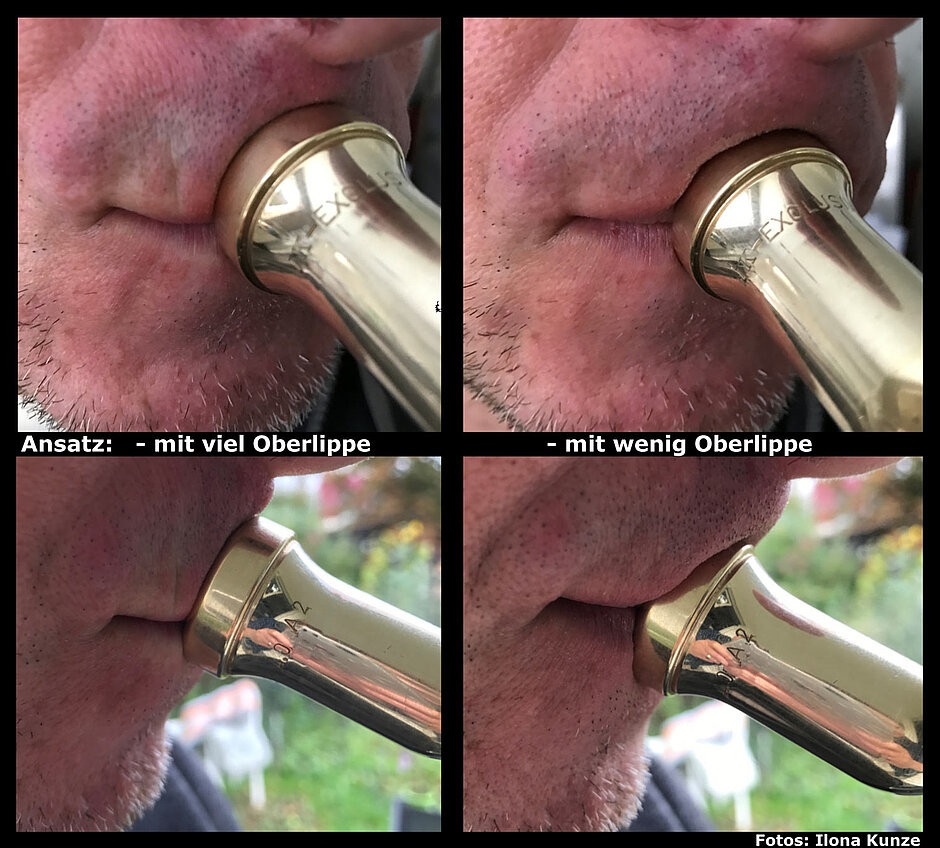Changing your embouchure on the trumpet
Embouchure and the challenges related to it are among the favourite subjects brass players like to discuss. Look for “trumpet embouchure” or “brass embouchure” in your favourite search engine and you will be overwhelmed by the sheer number of descriptions, challenges, pictures, etc. You will learn about where to hold the mouthpiece to your lips, and things like that. If you then search for famous trumpet players and look at action pictures of them, you may be surprised to note that they all use a different embouchure, which may be quite unlike the generally accepted “ideal placement”. Some will consider such embouchures “wrong”, even though the player in question plays surprisingly well (by “well” I just mean the stamina and range—not the musicality).

Various embouchure techniques
I myself am not too fond of instructions given in books and on the web regarding how to position the mouthpiece on your lips, i.e. 50:50, 70:30, etc. All players have different lips, so how could there be one universal embouchure that fits all? You can even use several embouchures if they help you achieve your goal.
I, for instance, use 2 different embouchure techniques and have tried many more, either just for the sake of it or because the situation required it. I remember playing entire shows with a “shifted embouchure”. Obviously, I have also found one embouchure that I consider essential. Feel free to experiment with different techniques—you can always revert to the original one if the new approach doesn’t seem to work. The only thing you need to be aware of is the consequences of any modification you make. Once the other aspects involved in playing a brass instrument are firmly in place, it is only a matter of changing the mindset. What is the role of the lips? They generate vibrations. Through their contact with the mouthpiece, they transmit their vibrations onto the instrument. The mouthpiece plays a supporting part, because it holds the lips in place.
Weak, Soft, Excessive
Weak is bad, because it essentially means that the lips hardly ever make contact with the mouthpiece. Already the slightest contact creates pressure, although it may be minimal. Soft makes a lot more sense. On the other hand, beware of applying too much pressure. Excessive pressure on the lips occurs when pitch changes are not accompanied by actively using the lips but rather by varying the pressure applied to them. Although this may work up to a point, you will eventually hit a wall. In this scenario, decreasing the pressure on the lips is only possible if we use the lips, i.e. the vibration generator, in a more flexible way to change the pitch. This can be achieved through lip buzzing.
Are there any approaches that are downright wrong for a stable embouchure?
“Downright wrong” is probably not the right term. I prefer to say: There are several embouchure techniques that may cause problems or restrict the player’s options. Those happy with playing the bottom trumpet voice and bereft of any ambition to become the star player who shines in the top register may get by with their “peculiar” embouchure for the rest of their lives.
A more ambitious player will soon realize that their current technique just won’t cut it. I must say, however, that I know someone who has been playing the first voice in a music society for years and who reaches the F3 effortlessly. His embouchure must be one of the weirdest I have ever seen. Instead of his upper lip, he uses the red area inside his mouth—the lip merely rests on the mouthpiece. Will this cause problems one day?
Discussing all aspects regarding embouchure lies beyond the scope of this article. There are different ways of training one’s lips to become more active while playing the trumpet.
I have chosen the buzzing trick, because it looked like the most direct approach.
Enjoy your experiments!


